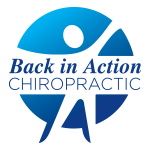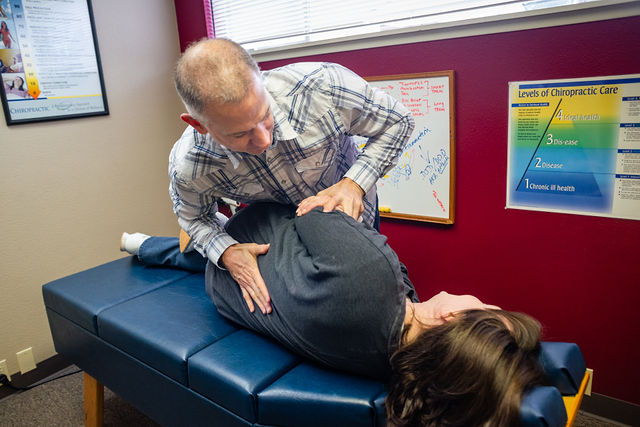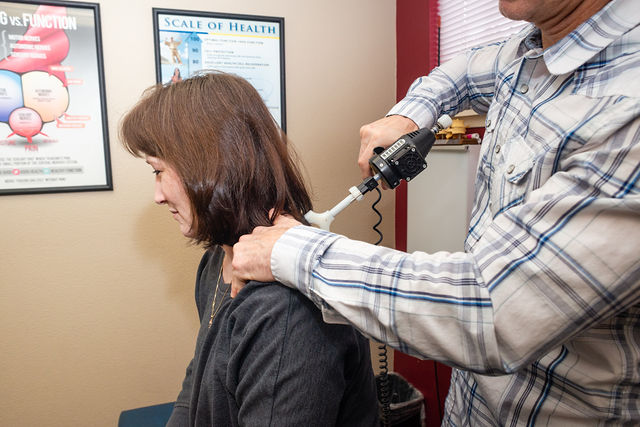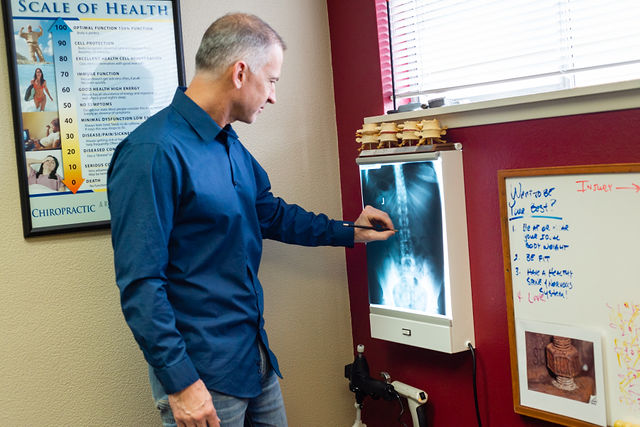Why Does My Neck Hurt?
Neck pain is one of the most common complaints we see at our Olympia chiropractic clinic. Whether it comes on suddenly or builds over time, the source is often more than just sore muscles. Your neck, or cervical spine, plays a critical role in supporting your head and facilitating movement, but it’s also vulnerable to strain, inflammation, and misalignment.
Even minor habits can lead to chronic discomfort if left unaddressed. Here are a few of the most common causes we identify during evaluations:
Tech Neck & Posture Strain
Poor desk ergonomics and frequent phone use can pull your spine out of alignment.
Injuries & Accidents
Whiplash, falls, and sports injuries can all damage soft tissues and joints.
Degenerative Conditions
Arthritis and disc wear can contribute to stiffness, instability, and nerve irritation.
Repetitive Strain
Frequent lifting, twisting, or carrying loads unevenly strains the neck over time.
Stress & Muscle Tension
Emotional stress often manifests as tight shoulders and neck discomfort.
Sleep Posture & Pillow Issues
Poor sleep support can misalign your cervical spine night after night.
Symptoms You Shouldn’t Ignore
It’s tempting to wait out neck pain, but early intervention can prevent long-term problems. Many patients don’t realize how connected their neck is to other parts of their body until symptoms begin to affect daily life.
If you’re experiencing any of the following, it’s time to get checked out:
Pain That Spreads
Discomfort radiating to your shoulders, arms, or hands could indicate nerve involvement.
Limited Range of Motion
Trouble turning your head or tilting your neck can point to joint restrictions.
Numbness, Tingling, or Weakness
These neurological signs shouldn’t be ignored—they often stem from cervical misalignment.
Persistent Headaches
Tension-type headaches frequently originate from neck strain.
Grinding or Popping
Sounds during movement may signal degenerative changes or joint restriction.
Pain When Waking Up
Morning stiffness often points to sleeping position or underlying inflammation.
If These Symptoms Sound Familiar, It’s Time to Take Action.
The sooner you address osteoarthritis, the better your chances of maintaining an active, pain-free lifestyle.
How Chiropractic Care Helps Neck Pain
Chiropractic focuses on identifying and correcting the root cause of dysfunction—not just managing symptoms. When it comes to neck pain, our goal is to restore healthy movement in the joints and reduce tension in surrounding tissues.
Our patients often report noticeable improvements in both comfort and mobility after just a few visits. Chiropractic can:
Restore alignment
Adjustments improve joint motion and ease pressure on nerves.
Reduce Muscle Tension
Manual therapies release tight or overworked soft tissues
Promote Natural Healing
Better circulation and nerve function help your body recover and rebalance.
What to Expect at Your Visit
Your first appointment at Back in Action starts with a thorough evaluation. We want to understand not just where you hurt, but why. This helps us build a care plan that’s personalized, practical, and rooted in your goals.
Thorough Consultation and Assessment
We begin with an in-depth discussion about your symptoms, medical history, and daily activities. Understanding how neck pain affects your life allows us to create a treatment plan tailored specifically to you.
Gentle Chiropractic Adjustments
Using precise, controlled techniques, we adjust misaligned joints to improve movement and reduce pain. These adjustments are customized to be safe for your body and it’s needs, ensuring you receive effective relief without unnecessary discomfort.
Gentle Chiropractic Adjustments
Using precise, controlled techniques, we adjust misaligned joints to improve movement and reduce pain. These adjustments are customized to be safe for your body and it’s needs, ensuring you receive effective relief without unnecessary discomfort.
Complementary Therapies
To treat neck pain, we may incorporate:
-
Spinal adjustments Gentle corrections that relieve joint restriction and improve movement.
-
Soft tissue therapy Techniques like myofascial release reduce inflammation and relieve trigger points.
-
Posture and mobility coaching Learn better habits for work, sleep, and movement to keep pain from returning.
-
Corrective exercises Targeted movements to stabilize weak areas and support spinal health.
-
Ergonomic recommendations We help adjust your workspace or sleep setup to reduce strain.
-
Stress-reduction strategies Chronic tension often improves with lifestyle shifts we can help guide.
Ongoing Support and Prevention
Our goal is to help you achieve long-term relief, not just temporary symptom management. We’ll provide guidance on lifestyle changes, ergonomic improvements, and home care strategies to keep your joints functioning at their best.
Ongoing Support and Prevention
Our goal is to help you achieve long-term relief, not just temporary symptom management. We’ll provide guidance on lifestyle changes, ergonomic improvements, and home care strategies to keep your joints functioning at their best.
How Long Until I Feel Better?
Healing looks different for everyone. Some patients notice immediate relief after an adjustment, while others improve steadily over a few weeks. Our job is to support your body’s healing process and track your progress.
What you can expect:
Early Relief
Many feel better within the first 1–2 visits, especially with acute tension.
Ongoing Improvements
Chronic or complex cases often respond well over 4–8 weeks of care.
Long-Term Gains
Maintenance visits and home care routines help prevent future flare-ups.
FAQs About Neck Pain and Chiropractic
Is chiropractic safe for neck pain?
Yes, when performed by a licensed chiropractor, cervical adjustments are safe and well-studied. We always adapt techniques to your comfort and needs.
What if I don’t want my neck “cracked”?
We offer low-force techniques and soft tissue therapies that don’t involve traditional joint manipulation.
Will I need to keep coming forever?
No. Our focus is on results and functional goals. Some patients choose periodic wellness visits after their main issue is resolved, but there is no one-size-fits-all plan.
Let’s Get You Moving Again
Don’t let neck pain keep you from working, sleeping, or living your life comfortably. The sooner we assess your condition, the sooner we can help you feel better.
Common Chiropractic Terminology:
Acute Back Pain
This is back pain from a recent injury or is endured for a short period of time. As opposed to chronic low back pain, which is persistent over an extended period of time.
Adjustment
Spinal adjustment and chiropractic adjustment are terms used by chiropractors to describe their approaches to spinal manipulation. An adjustment occurs when force is applied to a joint in order to increase mobility and change the alignment of bones in the body.
Chronic Back Pain
Back pain that persists for an extended period of time. Not treating pain when it initially occurs can lead to a problem becoming chronic in nature if the pain persists.
Herniated Disc
A condition which refers to a problem with a rubbery disc between the spinal bones. This condition occurs when the soft center of a spinal disc pushes through a crack in the tougher exterior casing and can irritate nearby nerves and result in pain, numbness, or weakness in an arm or leg.
Joint
The location at which two or more bones make contact. They are constructed to allow movement and provide mechanical support for the human body.
Ligament
A short band of tough, flexible fibrous connective tissue which connects two bones or cartilages or holds together a joint.
Massage
Massage is the gentle kneading of soft tissues used to increase circulation, decrease pain, relieve adhesions, and increase mobility.
Peripheral Neuropathy
Damage to nerves of the peripheral nervous system, which may be caused either by diseases of the nerve or from the side-effects of systemic illness.
Sciatica
Pain caused by a problem with the sciatic nerve that can cause pain in the lower back that spreads to the hip, buttocks, and leg.
Sprain/Strain
An injury in which both the muscles and ligaments of a specific joint or a region of the body have received damage. These injuries are commonly seen in car accidents, sporting accidents, whiplash injuries, etc.
Subluxation
A slight misalignment of the vertebrae, regarded in chiropractic theory as the cause of many health problems.




